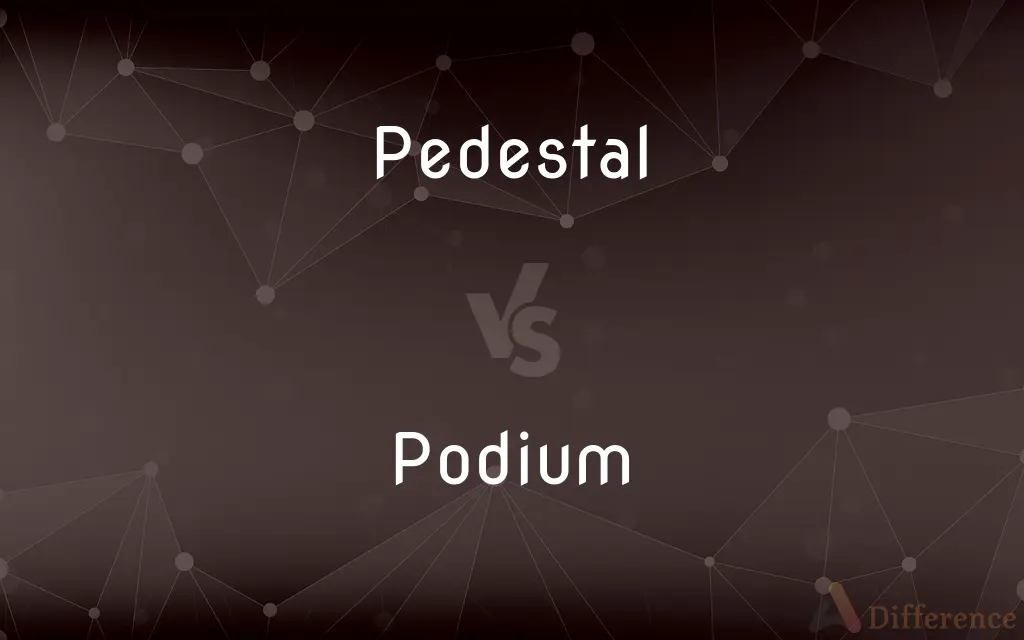Pedestal vs. Podium — What's the Difference?
By Tayyaba Rehman & Fiza Rafique — Updated on March 29, 2024
A pedestal elevates statues or objects, focusing on display, while a podium elevates people, emphasizing speech or performance.

Difference Between Pedestal and Podium
Table of Contents
ADVERTISEMENT
Key Differences
Pedestals are primarily used for supporting and highlighting statues, artworks, or other objects, serving as a base that elevates the item above its surroundings for better visibility and appreciation. They are often found in museums, galleries, and public spaces, where the emphasis is on the object being displayed. Podiums, on the other hand, are platforms used to raise a person or persons, typically for the purpose of speaking, conducting, or performing in front of an audience. They are commonly used in public speaking events, concerts, and awards ceremonies.
Pedestals can vary greatly in design, from simple plinths to elaborate sculptural works themselves, depending on their context and the importance of the object they support. Unlike pedestals, podiums are designed to accommodate people, often including features such as microphones, lecterns, or space for musical conductors to operate. This makes them a central focus in events where communication or performance is key.
The main distinction between the two lies in their purpose and design. Pedestals elevate objects to highlight their significance or beauty, while podiums elevate people to facilitate visibility and auditory communication with an audience.
Both pedestals and podiums play important roles in their respective contexts, with the choice between them depending on the needs of the event or display. While a pedestal might be chosen for an art exhibition to showcase a sculpture, a podium would be selected for a lecture or concert to ensure the speaker or performer is visible and heard.
In summary, while pedestals and podiums both serve to elevate, the former focuses on objects, and the latter on people. This fundamental difference dictates their design, use, and the contexts in which they are found.
ADVERTISEMENT
Comparison Chart
Primary Use
Elevating objects for display
Elevating people for visibility and speech
Context
Museums, galleries, public spaces
Public speaking, concerts, awards ceremonies
Design Focus
Supporting and highlighting objects
Accommodating people and communication tools
Features
Varied designs, often sculptural
Microphones, lecterns, space for performers
Impact on Audience
Aesthetic appreciation of objects
Auditory and visual engagement with speakers
Compare with Definitions
Pedestal
A base supporting a statue or vase.
The ancient Greek statue stood proudly on its marble pedestal.
Podium
A small platform for a speaker or conductor.
The conductor stepped onto the podium, baton in hand, ready to lead the orchestra.
Pedestal
A position of high regard or admiration.
Society often places celebrities on a pedestal, overlooking their flaws.
Podium
A platform for medal winners in sports.
The athletes stood proudly on the podium, medals shining around their necks.
Pedestal
A supporting structure for architectural elements.
The column was mounted on a pedestal for added stability and style.
Podium
A lectern or stand for holding speeches or lectures.
She approached the podium, her speech ready for the eager audience.
Pedestal
A foundation or basis for an argument or theory.
His hypothesis was placed on a shaky pedestal of unconfirmed data.
Podium
A base or support for something.
The sculpture was displayed on a sturdy podium, designed to complement its form.
Pedestal
An elevated platform for display purposes.
The museum displayed the rare gem on a pedestal in the center of the room.
Podium
A raised area in front of an audience.
The debate took place on a specially constructed podium in the auditorium.
Pedestal
A pedestal (from French piédestal, Italian piedistallo 'foot of a stall') or plinth is the support of a statue or a vase, and of a column in architecture. Smaller pedestals, especially if round in shape, may be called socles.
Podium
A podium (plural podiums or podia) is a platform used to raise something to a short distance above its surroundings. It derives from the Greek πόδι (foot).
Pedestal
An architectural support or base, as for a column or statue.
Podium
An elevated platform, as for an orchestra conductor or public speaker.
Pedestal
A support or foundation.
Podium
A stand for holding the notes of a public speaker; a lectern.
Pedestal
A position of high regard or adoration.
Podium
A low wall serving as a foundation.
Pedestal
To place on or provide with a pedestal.
Podium
A wall circling the arena of an ancient amphitheater.
Pedestal
(architecture) The base or foot of a column, statue, vase, lamp.
Podium
(Biology) A structure resembling or functioning as a foot.
Pedestal
(figuratively) A place of reverence or honor.
He has put his mother on a pedestal. You can't say a word against her.
Podium
To complete a competition, especially a race, as one of the top three contestants, usually being honored while standing on a podium.
Pedestal
(rail transport) A casting secured to the frame of a truck of a railcar and forming a jaw for holding a journal box.
Podium
A platform on which to stand, as when conducting an orchestra or preaching at a pulpit; any low platform or dais.
Pedestal
(machining) A pillow block; a low housing.
Podium
(sometimes proscribed) A stand used to hold notes when speaking publicly.
Pedestal
(bridge building) An iron socket, or support, for the foot of a brace at the end of a truss where it rests on a pier.
Podium
A steepled platform upon which the three competitors with the best results may stand when being handed their medals or prize.
Pedestal
(steam heating) a pedestal coil, group of connected straight pipes arranged side by side and one above another, used in a radiator.
Podium
(sports) A result amongst the best three at a competition.
Pedestal
(telecommunications) A ground-level housing for a passive connection point for underground cables.
Podium
A low wall, serving as a foundation, a substructure, or a terrace wall.
Pedestal
(electronics) The measured value when no input signal is given.
Podium
The dwarf wall surrounding the arena of an amphitheatre, from the top of which the seats began.
Pedestal
(aviation) The central part of the cockpit, between the pilots, where various controls are located.
Podium
The masonry under the stylobate of a temple, sometimes a mere foundation, sometimes containing chambers.
Pedestal
The tough protuberant pad covering a dromedary's sternum, which, when the camel lies down, causes the abdomen to be slightly above the hot ground.
Podium
A foot or footstalk.
Pedestal
To set or support on (or as if on) a pedestal.
Podium
To finish in the top three at an event or competition.
The swimmer podiumed three times at the Olympics.
Pedestal
The base or foot of a column, statue, vase, lamp, or the like; the part on which an upright work stands. It consists of three parts, the base, the die or dado, and the cornice or surbase molding. See Illust. of Column.
Build him a pedestal, and say, "Stand there!"
Podium
A low wall, serving as a foundation, a substructure, or a terrace wall.
Pedestal
A short free-standing column or column-like object designed to support a work of art or other object; a column serving the same function as the base of a statue. It may be made of wood, marble, or other suitable material.
Podium
The foot.
Pedestal
A part of a desk which contains a frame and drawers, stands on the floor, and provides support for the desk surface. There may be zero, one, or two such pedestals in a desk.
Podium
A platform raised above the surrounding level to give prominence to the person on it
Pedestal
A casting secured to the frame of a truck and forming a jaw for holding a journal box.
Pedestal
A support or foundation;
The base of the lamp
Pedestal
A position of great esteem (and supposed superiority);
They put him on a pedestal
Pedestal
An architectural support or base (as for a column or statue)
Common Curiosities
What is a pedestal used for?
A pedestal is used to elevate and display objects such as statues, vases, or artworks, emphasizing their visibility and aesthetic appeal.
What materials are used to make pedestals?
Pedestals can be made from a variety of materials, including wood, stone, metal, and more, depending on the design and context.
Are pedestals always decorative?
While many pedestals are decorative to complement the object they support, some are simple and functional, focusing on stability and elevation.
How do podiums enhance public speaking events?
Podiums raise speakers above the audience, improving visibility and sound projection, and often include features like microphones or lecterns to assist with the presentation.
What is a podium used for?
A podium is used to elevate people, typically speakers or performers, making them more visible and audible to an audience.
Can a podium have multiple uses?
Yes, podiums can be used for public speaking, musical performances, conducting, and even in sports for medal ceremonies.
Is there a size standard for pedestals and podiums?
There is no strict size standard, as the dimensions can vary greatly depending on the intended use, object or person being elevated, and the space available.
Can a pedestal also serve as a podium?
Typically, no. Pedestals are designed for objects, not people, focusing on aesthetics rather than functionality for speakers or performers.
What materials are podiums made from?
Podiums are often made from wood, metal, or modern composites, chosen for durability, aesthetics, and the ability to support weight and equipment.
How does the design of a pedestal affect the displayed object?
The design of a pedestal can enhance or detract from the displayed object, influencing how it is perceived in terms of importance, style, and context.
Why are podiums important in competitions?
Podiums visually distinguish the winners, elevating them for recognition and celebration during medal ceremonies.
Do all public speaking events use podiums?
Not all, but many public speaking events use podiums to improve speaker visibility and audio quality, though some speakers may choose to speak without one.
Can the design of a podium be customized?
Yes, podiums can be customized in design and features to suit specific events or preferences, including branding, technology integration, and accessibility.
How does one choose between a pedestal and a podium?
The choice depends on the purpose: pedestals for displaying objects and podiums for elevating people for speeches or performances.
Can podiums and pedestals be used outdoors?
Yes, both can be designed for outdoor use, using materials and construction methods suited to withstand weather conditions.
Share Your Discovery

Previous Comparison
Grub vs. Maggot
Next Comparison
Amenity vs. FacilityAuthor Spotlight
Written by
Tayyaba RehmanTayyaba Rehman is a distinguished writer, currently serving as a primary contributor to askdifference.com. As a researcher in semantics and etymology, Tayyaba's passion for the complexity of languages and their distinctions has found a perfect home on the platform. Tayyaba delves into the intricacies of language, distinguishing between commonly confused words and phrases, thereby providing clarity for readers worldwide.
Co-written by
Fiza RafiqueFiza Rafique is a skilled content writer at AskDifference.com, where she meticulously refines and enhances written pieces. Drawing from her vast editorial expertise, Fiza ensures clarity, accuracy, and precision in every article. Passionate about language, she continually seeks to elevate the quality of content for readers worldwide.
















































